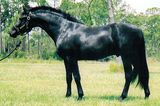
Friesian Sporthorses are sleek, elegant horses that are specifically bred for sporting events, hence their name. They are a Friesian crossbreed of the sport horse type. Friesian horses, originating in the Netherlands and Germany, are graceful and nimble horses that are typically used for recreation, while their athletic Friesian Sporthorse relatives are often used for competitions and performances.
Although Friesian Sporthorses are athletic enough to perform well in jumping competitions and the like, the breed is also sought out for recreational purposes by individuals, especially trail riders. They are gentle and careful enough to accommodate riders of all ages.
Size
15.2 and 17 hands in height.
Colours
The common coat colors of the Dutch Warmblood horses are brown, black, chestnut, gray or bay. White markings on the coat is a common occurrence and poses no problems for registration.
Suitable for
Throughout their history, Friesian Sporthorses were extensively used as workhorses in the agricultural sector due to their strength and temperament.
But as the need for such agricultural workhorses declined, the breed became popular for recreational uses and competitions, notably dressage. In general, these horses can excel in almost any area—from the show ring to casual family rides. This breed is very well-rounded.
History
The practice of crossbreeding Friesian horses has been common since the late 19th century, when Friesians were quite popular in the Netherlands and Germany. Even so, registries did not recognize the offspring of these crossbred individuals for decades to come.
In 2007, a studbook for Friesian Sporthorses was founded by the Friesian Sporthorse Association, also known as the FSA. The FSA trademarked the name Friesian Sporthorse the following year.
The FSA was initially founded in the United States, but shortly thereafter a branch was added in Australia, and the Friesian Sporthorse Association now registers Friesian Sporthorses worldwide.
:max_bytes(150000):strip_icc():format(webp)/what-horses-eat-that-keep-them-healthy-1886504-FINAL-5ba8dd3746e0fb0025eb2cb4.png)
:max_bytes(150000):strip_icc():format(webp)/horse-eye-resized-56a4dbf03df78cf77284fe95.jpg)
:max_bytes(150000):strip_icc():format(webp)/Horse-grooming-GettyImages-495726400-5876f27d5f9b584db351222e.jpg)
:max_bytes(150000):strip_icc():format(webp)/close-up-of-hand-holding-parrot-705172843-5b52bc4ec9e77c0037b6e5a4.jpg)
:max_bytes(150000):strip_icc():format(webp)/GettyImages-579524112-5c77331146e0fb000140a3a6.jpg)
:max_bytes(150000):strip_icc():format(webp)/budgerigarsonrope-331834_1920-5b628213c9e77c00255b32bc.jpg)
:max_bytes(150000):strip_icc():format(webp)/GettyImages-106887241-58325bc03df78c6f6a9a2ed2.jpg)
:max_bytes(150000):strip_icc():format(webp)/GettyImages-878015800-06106157c9d34a2081db4abcae8699b1.jpg)
:max_bytes(150000):strip_icc():format(webp)/hungry-cat-57b72fac5f9b58cdfda11a62.jpg)


:max_bytes(150000):strip_icc():format(webp)/4374985466_59c7f6545b_o-8b4f24f2f3e544349fe537fde58cfad0.jpg)
:max_bytes(150000):strip_icc():format(webp)/GettyImages-9298737261-500c5a2fba4248f89d1c17a33bf438f7.jpg)
:max_bytes(150000):strip_icc():format(webp)/veterinarian-and-owners-examining-dog-in-vet-s-surgery-164853745-dbecbdb691d549d79487d84356920cf4.jpg)